BMW 7 Series (E65)
The BMW E65 is the fourth generation of the BMW 7 Series range of full-size luxury sedans, and was produced from 2001 to 2008. The variants of the range are:
- sedan (E65 model code)
- long-wheelbase sedan (E66 model code)
- armoured car sedan (E67 model code, marketed as High Security 7 Series)
- hydrogen-powered sedan (E68 model code, marketed as Hydrogen 7)
| BMW 7 Series (E65/E66/E67/E68) | |
|---|---|
_sedan_(2015-07-09)_01.jpg) | |
| Overview | |
| Manufacturer | BMW |
| Production | July 2001 – 2008 |
| Assembly |
|
| Designer |
|
| Body and chassis | |
| Class | Full-size luxury car (F) |
| Body style | 4-door sedan |
| Layout | Front-engine, rear-wheel drive |
| Related | Alpina B7 (E65) |
| Powertrain | |
| Engine | |
| Transmission | 6-speed automatic |
| Dimensions | |
| Wheelbase |
|
| Length |
|
| Width | 1,902 mm (74.9 in) |
| Height | 1,484–1,492 mm (58.4–58.7 in) |
| Kerb weight | 1,710–2,040 kg (3,770–4,497 lb) |
| Chronology | |
| Predecessor | BMW 7 Series (E38) |
| Successor | BMW 7 Series (F01) |
The E65 was the first BMW vehicle to include the iDrive infotainment system, the new brand design language, active anti-roll bars, a 6-speed automatic transmission, an electronic smart Key (dispensing with the traditional metallic key), and night vision. The 760i model also utilised the world's first production V12 engine to use direct injection.[2][3]
In late 2008, the E65 7 Series was replaced by the 7 Series (F01).
Development and launch
Development for the BMW E65 7 Series began in early 1996. In early 1997, Chris Bangle delivered a brief to BMW's Munich and DesignworksUSA studios. After a competition between 20 designers, Adrian van Hooydonk's design was approved in the spring of 1998.[4] Production specifications were frozen in January 1999 and took 34 months from freeze to market launch.[5][6][7][8] The design was patented on 16 November 2000[9] and development ended in early 2001.
The E65 was introduced at the Frankfurt Auto Show in September 2001,[10][11][12] and launched in Europe on November 2001.[13] The launch model in the U.S. was the 745i model, which was released in January 2002, followed by the long-wheelbase 745Li in March.[14][15]
In order to produce the E65 7 Series and other future models, the BMW Dingolfing plant was retooled at a cost of approximately €500,000,000.[16]
Design
Exterior styling
Under the direction of Chris Bangle, BMW's Design Chief at the time, the BMW E65 7 Series heralded a new styling era for BMW.[17]
BMW's board of directors were keen to move the company's image into the future, and the initial styling sketches from 1998 by Adrian van Hooydonk were of a fastback body style - even more radical than the eventual production model.[18] The controversial "flame surfacing" design[19][20] greatly contrasted the conservative lines of its E38 predecessor. The rear end styling was nicknamed "Bangle Butt" by critics, due to the elongated rear bootlid.[21][22]
Dimensionally the E65 7 Series is 45 mm (1.8 in) longer, 38 mm (1.5 in) wider and 60 mm (2.4 in) taller than the E38.[23] The wheelbase is 2,990 mm (117.7 in),[24] an increase of 60 mm (2.4 in) over the outgoing model. Despite these increased dimensions, the E65 7 Series is only 15 kg (33 lb) heavier than the E38.
Interior styling
The E65 contained many departures from automotive interior design conventions. BMW removed the traditional console mounted gear selector, replacing it with a steering-column mounted stalk[20][25] in favour of two cup holders. The e-brake is controlled using a button on the dashboard.[26] The seat adjustment controls were moved from their traditional place on the side of the seat base to the inside of the raised central console, which drew some criticisms.[23] Unlike most BMWs since 1975 (including the E65's predecessor and successor), the centre instrument panel is not angled towards the driver.[27]
Compared to the outgoing E38 model, the E65 7 Series has more shoulder room in the front and the rear, and increased rear headroom.
iDrive
The E65 was the first BMW to use the iDrive infotainment system.[28] The system was built on the Windows CE for Automotive platform,[29] and featured an interface primarily based around a central control knob. Many of the functions such as climate, navigation, seat heating, telephony, and car settings were incorporated into a single system allowing for centralised control. Early versions of iDrive were criticised for complicated menu structures and a steep learning curve.[30][23]
The first generation of the system relied on CD media for map data. In March 2003, the maps switched to DVD format,[31] a faster processor was used and a 'Menu' and 'Customisable' button were added below the control knob. In 2005, dedicated buttons were added to change radio stations or skip tracks[32] and a brighter screen was used for the 8.8" widescreen option.
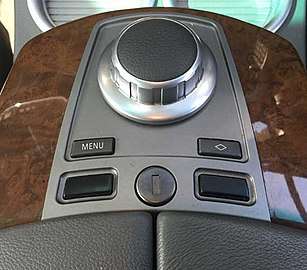 iDrive controller (2005+)
iDrive controller (2005+)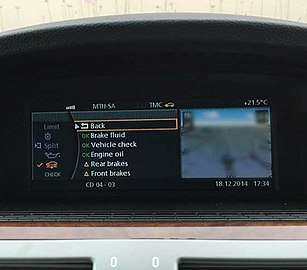 iDrive showing service items (2005+)
iDrive showing service items (2005+) iDrive showing climate menu (2005+)
iDrive showing climate menu (2005+)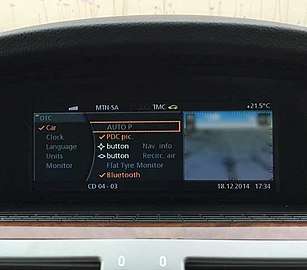 iDrive showing settings menu (2005+)
iDrive showing settings menu (2005+)
Equipment
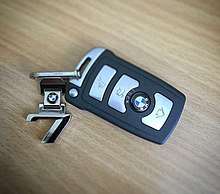
The E65 was the flagship model[33] and the most technologically advanced car produced by BMW at the time.
The following features were first introduced on the E65:
- V8 models were the first to use BMW's new N62 V8 engine, which was the world's first engine to use a continuously variable-length intake manifold.[34] It was also BMW's first V8 engine to use variable valve lift (Valvetronic),[35][36] replacing throttle butterflies (during normal running conditions) for added response, efficiency and power.[37]
- Active anti-roll bars (Active Roll Stabilisation) to reduce body roll when cornering. It uses a hydraulic servo in the middle of the anti-roll bar to actively counteract body roll and to reduce body roll without the traditional trade-off in ride comfort.
- Directional headlights (Adaptive Headlights) which electronically adjust the low beam lights horizontally (during turns) and vertically (based on rear axle load) adjustment of the low beam. Also, the E65 was the first BMW available with bi-Xenon (HID) headlights.
- World’s first 6-speed automatic transmission in a sedan.[38][39]
- World's first car with an electric park brake. This could automatically activate in stop-and-go traffic situations and when the ignition was switched off.
- First BMW with DVD-based GPS Automotive navigation system.
- Adaptive Cruise Control (ACC), however this was available in some markets on the previous generation 7 Series (E38).
- The optional Automatic Soft Close system minimized the force required to close the doors and boot lid, and would completely close them if improperly closed.
- Two fibre optic electronic networks: MOST Bus (Media Orientated System Transport)[40][41] and "Byteflight" (safety systems bus). These busses operate at 22.5Mbit/s and 10Mbit/s respectively. Also, the I-bus, K-bus and P-bus were replaced by the K-CAN (Body-Controller Area Network). This increased the system speed from 9.6kbit/s to 100kbit/s.
Models
Petrol engines
| Model | Engine | Years | Power | Torque | 0-100 km/h (0-62 mph) |
|---|---|---|---|---|---|
| 730i | M54B30 3.0 L I6 | 2004–2005 | 170 kW (228 bhp; 231 PS) at 5,900 rpm |
300 N⋅m (221 lb⋅ft) at 3,500 rpm | 8.1 s |
| N52B30 3.0 L I6 | 2005–2008 | 190 kW (255 bhp; 258 PS) at 6,600 rpm | 300 N⋅m (221 lb⋅ft) at 2,500–4,000 rpm | 7.8 s | |
| 735i | N62B36 3.6 L V8 | 2001–2004 | 200 kW (268 bhp; 272 PS) at 6,200 rpm | 360 N⋅m (266 lb⋅ft) at 3,700 rpm | 7.5 s |
| 740i | N62B40 4.0 L V8 | 2004–2008 | 225 kW (302 bhp; 306 PS) at 6,300 rpm | 390 N⋅m (288 lb⋅ft) at 3,500 rpm | 6.8 s |
| 745i | N62B44 4.4 L V8 | 2001–2004 | 245 kW (329 bhp; 333 PS) at 6,100 rpm | 450 N⋅m (332 lb⋅ft) at 3,600 rpm | 6.3 s |
| 750i | N62B48 4.8 L V8 | 2004–2008 | 270 kW (362 bhp; 367 PS) at 6,300 rpm | 490 N⋅m (361 lb⋅ft) at 3,400 rpm | 5.9 s |
| 760i | N73B60 6.0 L V12 | 2002–2008 | 327 kW (439 bhp; 445 PS) at 6,000 rpm | 600 N⋅m (443 lb⋅ft) at 3,950 rpm | 5.5 s |
| Alpina B7 | N62B44 V8 S/C | 2003–2008 | 368 kW (493 bhp; 500 PS) at 5,500 rpm | 700 N⋅m (516 lb⋅ft) at 4,250 rpm | 4.9 s |
Diesel engines
| Model | Engine | Years | Power | Torque | 0-100 km/h (0-62 mph) |
|---|---|---|---|---|---|
| 730d | M57D30TU 3.0 L I6 turbo | 2002–2005 | 160 kW (215 bhp; 218 PS) at 4,000 rpm | 500 N⋅m (369 lb⋅ft) at 2,000 rpm | 8.0 s |
| M57D30TU2 3.0 L I6 turbo | 2005–2008 | 170 kW (228 bhp; 231 PS) at 4,000 rpm | 520 N⋅m (384 lb⋅ft) at 2,000–2,750 rpm | 7.8 s | |
| 740d | M67TUD40 3.9 L V8 twin-turbo | 2002–2004 | 190 kW (255 bhp; 258 PS) at 4,000 rpm | 600 N⋅m (443 lb⋅ft) at 1,900–2,500 rpm | 7.4 s |
| 745d | M67D44 4.4 L V8 twin-turbo | 2005 | 220 kW (295 bhp; 299 PS) at 4,000 rpm | 700 N⋅m (516 lb⋅ft) at 1,750–2,500 rpm | 6.8 s |
| M67TUD44 4.4 L V8 twin-turbo | 2005–2008 | 242 kW (325 bhp; 329 PS) at 3,800 rpm | 750 N⋅m (553 lb⋅ft) at 1,900–2,500 rpm | 6.6 s |
Special models
Alpina B7
_rr.jpg)
The Alpina B7 prototype was introduced to the public at the 2003 Geneva Motor Show in March, and the production version was later unveiled at the 2003 Frankfurt Motor Show.[43] Production began in February 2004,[44] and was built in the Dingolfing BMW plant alongside the regular E65 models.
The Alpina B7 uses a supercharged version of the 4.4-litre V8 found in the 745i, and was the first Alpina model to feature a supercharged engine.[45]
Exterior changes include a rear spoiler[43] and 21-inch traditional Alpina multi-spoke style wheels. Interior changes include sports seats, an Alpina instrument cluster, a three spoke steering wheel with shift buttons, and a silver plated production plaque.
803 units were produced for North America, and 311 cars were produced for other countries.
Long-Wheelbase 7 Series (E66)
The E66 long-wheelbase models, badged "Li" were introduced in June 2002. Long-wheelbase models are 140 mm (5.5 in) longer, allowing for extra rear legroom.[46] The initial long wheelbase models were the 735Li, 745Li and 760Li In 2003, 730Li, 730Ld, 740Li and 750Li model was added to the lineup in 2005. [47][48]
BMW High Security 7 Series (E67)
The E67 High Security 7 Series is an armoured variant of the BMW 7 Series. The 760Li High Security was introduced at the 2003 Geneva Motor Show, with the 745Li High Security model released later in September 2003.[49]
E65 High Security models are designed to withstand attacks, and meet the requirements of the B7 weapons standard.[50] Security features include a detachable multi-layer laminated windscreen, a remote starting system, a fire extinguishing system, a fresh air system, and under-body protection.[51] High Security models also feature run flat tyres, with Michelin’s PAX system; which allows continuous driving of 80 km/h (50 mph) for approximately 50 km (31 mi), with a puncture.[51]
BMW offers a buyback service for High Security models up to 7 years old, which are inspected then resold to potential customers worldwide. A training course is also offered to owners and chauffeurs, and teaches car control in case of emergency situations.[49]
BMW Hydrogen 7 (E68)
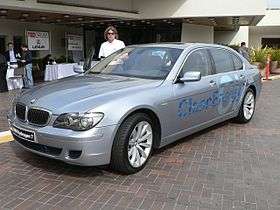
The BMW Hydrogen 7 is a limited production hydrogen-fueled model. It uses a modified version of the 760Li's N73 V12 engine, producing 191 kW (256 bhp). Claimed fuel economy is 50 L/100 km (4.7 mpg‑US) and the hydrogen is stored as a liquid in an insulated 170 L (45 US gal) tank. Only 100 cars were made, which were leased to high-profile customers, in order to promote the use of hydrogen vehicles.
Model year changes
2003
- iDrive updates: Addition of 'Menu' and 'Customisable' buttons, maps switched to DVD format, and a faster processor was used.
- 760i & 760Li V12 model was introduced.
2005 facelift
In March 2005, the E65 facelift was introduced.[52] In the United States, it was sold as the 2006 model year.
The major changes are:
- Revised styling for front and rear bodywork, headlights and tail-lights (including removal of the centre light bar running across the boot lid).[53] BMW offered "conversion kits" that could be purchased by existing owners to apply these exterior changes to pre-facelift cars.[52]
- iDrive updates including a simplified interface, clearer graphics, and the iDrive controller now having a leather top surface.[54]
- 740i, 750i, and 745d engines introduced as replacements.[52]
- 730i and 730d engines received minor performance and efficiency upgrades.
- Rear track width increased by 14 mm (0.55 in).[55]
- Adaptive cruise control upgraded to ACC II.
Pre-facelift styling
 Front (745i)
Front (745i)_sedan_(2016-08-27).jpg) Rear (735i)
Rear (735i)
Post-facelift styling
_Facelift_front_20100718.jpg) Front (730d)
Front (730d)_Facelift_rear_20100718.jpg) Rear (730d)
Rear (730d)
Late 2005
In late 2005, BMW introduced BMW Night Vision[56] which uses passive infrared and processes far infrared radiation,[57] to minimise non-essential information, placing a greater emphasis on pedestrians and animals. It allows for a range of 300 m (980 ft), and avoids "dazzle" from headlights, road lights and similar intense light sources.[58]
At the same time, automatic beam switching (High-Beam Assistant) was introduced. This system detects oncoming light sources to automatically engage the high beam lights in dark areas and then dip the high beam lights to avoid dazzling oncoming traffic.[58]
Production volumes
The following are production figures for E65 7 Series models:
| Year | Total |
|---|---|
| 2001 | 2,979 |
| 2002 | 50,961 |
| 2003 | 57,899 |
| 2004 | 47,689 |
| 2005 | 50,062 |
| 2006 | 50,227 |
| 2007 | 44,421 |
| 2008 | 38,835 |
| Total: | 343,073 |
References
- "BMW 7 series to be added to production in Cairo from 2nd half of 2006". www.press.bmwgroup.com. Retrieved 24 March 2018.
- "BMW World - 12 cylinder engines". www.usautoparts.net. Archived from the original on 27 June 2013.
- "BMW 760Li - First Drive Review". www.caranddriver.com. Retrieved 18 May 2017.
- "An Interview with BMW's Chief Designer". Bloomberg.com. Retrieved 20 May 2017.
- "BMW : Reorganization and strengthening of the Board". Autointell-news.com. 7 February 1999. Retrieved 19 June 2018.
- "Adrian Van Hooydonk - The Man To Take BMW Design Further". Bmwblog.com. 10 February 2009. Retrieved 19 June 2018.
- https://www.just-auto.com/analysis/a-beginners-guide-to-the-new-bmw-7-series_id86797.aspx
- http://www.motortrend.com/news/2009-bmw-750li-stalin-would-be-proud-2038/
- "Registerauskunft zum Design Designnummer: 40010998-0001". Deutsches Patent- und Markenamt. Retrieved 12 April 2017.
- "BMW 7-Series - 2001 Frankfurt Motor Show". www.youtube.com. Retrieved 26 May 2017.
- "BMW 7-series - Auto Shows". www.caranddriver.com. Retrieved 26 May 2017.
- "Frankfurt Motor Show 2001 - Highlights". www.cardesignnews.com. Archived from the original on 15 December 2006.
- "2002 BMW 7 Series First Look". www.motortrend.com. Retrieved 26 May 2017.
- "BMW 7-Series - First Drive Review Page 2". www.caranddriver.com. Retrieved 26 May 2017.
- "Used 2002 BMW 7 Series". www.edmunds.com. Retrieved 9 June 2017.
- Annual Report 2001 (PDF). BMW AG. p. 19. Retrieved 7 May 2017.
- "The Chris Bangle Legacy". www.bmwstyle.tv. Retrieved 26 May 2017.
- "Design Icons: A look back at the E65 BMW 7 Series". www.formtrends.com. Retrieved 26 May 2017.
- "Does Chris Bangle Deserve A Lifetime Achievement Award For Car Design?". www.jalopnik.com. Retrieved 26 May 2017.
- "The Bavarian luxobarge: A look back at the BMW 7-series". www.autoweek.com. Retrieved 26 May 2017.
- "Chris Bangle Recalls Controversial BMW 7 Series Design". www.nytimes.com. Retrieved 26 May 2017.
- "The Bangle Butt". www.bmwblog.com. Retrieved 26 May 2017.
- "BMW 7 Series - A Look Back". www.topspeed.com. Retrieved 1 June 2017.
- "BMW 7-Series Saloon 730d Sport 4d Auto (03) specs & dimensions | Parkers". www.parkers.co.uk. Retrieved 13 June 2018.
- "BMW 7 Series". www.motoring.com.au. Retrieved 1 June 2017.
- "BMW 735i Review". www.thetruthaboutcars.com. Retrieved 1 June 2017.
- "BMW F01 Interior: Interview with Designers". www.paultan.org. Retrieved 28 May 2017.
- "iDrive vs. Other Infotainment Systems". www.bmwblog.com. Retrieved 1 June 2017.
- "Will BMW's Infotainment Solution iDrive You up the Wall?". Lifewire. Retrieved 19 February 2018.
- "BMW 7 Series Review". www.edmunds.com. Retrieved 1 June 2017.
- "7' E65 730i Navigation system". www.realoem.com. Retrieved 1 June 2017.
- "7' E65 760i Controller". www.realoem.com. Retrieved 1 June 2017.
- "7 Series - E65/E66 (2001 - 2008)". www.bmwheaven.com. Retrieved 9 June 2017.
- Hirschfelder, Klaus; Völkl, Werner; Kühnel, Hans-Ulrich; Sinn, Walther; Huck, Armin (March 2002). "The first continuously variable intake system in the new eight-cylinder engine from BMW". MTZ Worldwide. 63 (3): 2–6. doi:10.1007/bf03227525. ISSN 2192-9114.
- "BMW Engines: From M to N - Part 2". BMW BLOG. 27 December 2008. Retrieved 19 February 2018.
- "Bob Harper BMW E65 - Drive". Drive. Retrieved 19 February 2018.
- "BMW E65 - Drive". www.drive-my.com. Retrieved 3 June 2017.
- "BMW 7er, Modell E65, Technique in Detail: automatic transmission by ZF". schuett.info. Retrieved 19 February 2018.
- "ZF ends six-speed auto gearbox production from Germany - Autocar India". www.autocarindia.com. Retrieved 19 February 2018.
- "E65 BUS SYSTEMS" www.xolmatic.com/xprojects/XE65/MOST/bus%20system.pdf. Retrieved 2018-02-19.
- "BMW 7 SERIES 2005 E65 MOST Bus Diagnosis Workshop Manual". www.carmanualsonline.info. Retrieved 19 February 2018.
- "RealOEM.com - Select Your BMW Model". www.realoem.com. Retrieved 19 February 2018.
- "2003-2008 Alpina B7". www.ultimatecarpage.com. Retrieved 11 June 2017.
- "ALPINA Automobiles based on BMW 7 Series- E65 / E66". www.alpina-automobiles.com. Retrieved 11 June 2017.
- "Milestones: ALPINA Automobiles". www.alpina-automobiles.com. Retrieved 11 June 2017.
- "Road Test BMW 745i". www.caranddriver.com. Retrieved 13 June 2017.
- "2004 745 New Car Test Drive". www.autoblog.com. Retrieved 13 June 2017.
- "2003 BMW 760Li vs. M-B S600 - Comparison Tests". www.caranddriver.com. Retrieved 13 June 2017.
- "World Debut of the BMW 760Li High Security and the BMW 330i Security at the 2003 Geneva Motor Show". BMW Press Group. Retrieved 15 June 2017.
- "BMW 7 Series High Security". bmw-ids.com. Archived from the original on 10 April 2003. Retrieved 15 June 2017.
- "BMW 7 Series High Security". bmw-ids.com. Archived from the original on 11 December 2008. Retrieved 15 June 2017.
- "Participant's Manual - E65/E66 Model Redesign" (PDF). www.share.qclt.com. Retrieved 17 June 2017.
- "Top Five LCI Updates". www.bmwblog.com. Retrieved 17 June 2017.
- "2006 BMW 7 Series - Sedan 4D 750i". www.nadaguides.com. Retrieved 17 June 2017.
- "2006 BMW 7-Series". www.thecarconnection.com. Retrieved 17 June 2017.
- "BMW Ad - 7 Series with Night Vision". www.youtube.com. Retrieved 17 June 2017.
- "BMW incorporates thermal imaging cameras in its cars" (PDF). www.flir.com. Archived from the original (PDF) on 30 August 2017. Retrieved 17 June 2017.
- "BMW announces Night Vision and High-Beam Assistant". BMW Group. 21 July 2005. Retrieved 1 July 2015.
| Wikimedia Commons has media related to BMW E65. |
| Wikimedia Commons has media related to BMW E66. |
.jpg)